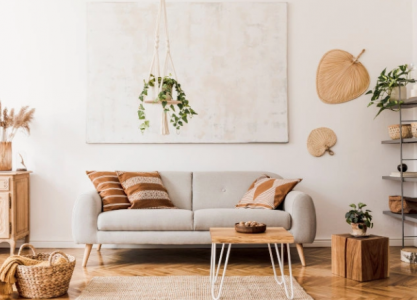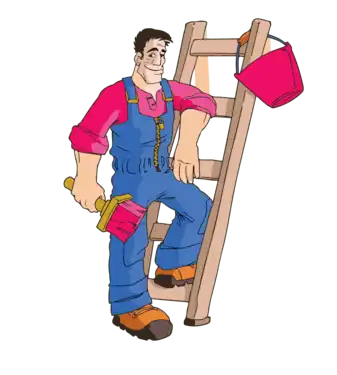Choosing Wall Finishes: Exploring the Differences Between Wallpaper, Wall Texture, and Stencil Painting
Table of Contents
House Wallpaper vs Wall Texture vs Stencil Painting. Differences
House Wallpaper
House wallpaper is a classic and versatile choice for wall decor. It involves applying a paper or vinyl covering with various patterns, textures, and designs to the walls. This option offers a wide range of design possibilities, allowing you to achieve the desired look for your room.
It is a decorative covering for walls made from sheets of paper which is installed to the walls using wallpaper paste. The sheets of paper are crafted in digital print, 3D illustrations, geometric shape designs, murals, traditional motifs or themed pattern designs etc. various materials are used to a top coating of the wallpaper sheets such as polished metal foil wallpaper, vinyl layer coated wallpaper, mylar wallpaper is a paper based on the top of it polyester film coated, bamboo wallpaper handcrafted from natural bamboo and glued to paper.
Pros:
- Diverse Designs: Wallpaper offers an extensive array of designs, from traditional to modern, and can mimic various materials like wood, stone, or fabric.
- Easy Installation: With advancements in technology, many wallpapers come with adhesive backing, making them easier to install.
- Durability: High-quality wallpapers can last for many years without fading or peeling.
- Easy to Clean: Most wallpapers are easy to clean and maintain, making them a practical choice for high-traffic areas.
Cons:
- Removal Challenges: Removing wallpaper can be time-consuming and may require special tools and techniques.
- Susceptible to Moisture: Some wallpapers may not fare well in areas prone to moisture, like bathrooms or kitchens.
Wall Texture
Wall texture involves adding a three-dimensional texture to the walls, creating visual interest and depth. This is achieved through various techniques, such as applying plaster, stucco, or textured paints.
Texture paint is a coarse gritty application of paint with various tools such as thread or ribbon, designed roller brushes, hair combs, knives, rags, etc. The combination of these tools helps in adding texture to a plain wall which helps in adding shapes like 3D effects on the walls. The right colour combination can work wonders in portraying the texture of the wall. Being a water-based paint, it is less toxic than oil paint. It is also used to cover imperfections in unfinished walls. This paint can be suitable for all types of climatic conditions as it protects the wall from mold, fungus, or algae.

Pros:
- Enhances Aesthetics: Wall textures can add depth and character to a room, creating a unique and appealing visual impact.
- Camouflages Imperfections: Texturing can help hide minor wall imperfections and irregularities.
- Versatile Options: There are numerous texture styles to choose from, including smooth, coarse, or raised patterns.
Cons:
- Labor-Intensive: Achieving the desired texture can require significant time and effort, especially for intricate patterns or designs.
- Difficult to Change: Altering the texture can be challenging once applied, necessitating a fresh coat of paint or a new texture layer.
Stencil Painting
Stencil painting involves using stencils to create intricate patterns or designs on the walls. It allows for artistic expression and customization, adding a personal touch to your space.
Wall stencils are pre-cut designs made of thin, flexible materials such as plastic or cardboard that are used to create a stencil-painted design on a wall. In the stencil wall painting process, a stencil template design is placed on the wall and then paint is applied using a brush, roller or spray gun. Thus when the stencil on the wall is removed a pattern or design gets printed on the wall. A stencil is often used to create a design on an entire wall or a portion of it.

Pros:
- Creativity and Personalization: Stencils offer the flexibility to create unique patterns or designs that suit your taste and style.
- Cost-Effective: Stencil painting can be more budget-friendly than other decorative options, especially if you DIY.
Cons:
- Labor-Intensive: Achieving a polished look with stencil painting can require precision and time.
- Limited Design Scale: Stencil designs may be limited in size or scale, depending on the stencil template.
- In conclusion, the choice between house wallpaper, wall texture, and stencil painting ultimately depends on your preferences, budget, and the specific look you want to achieve. Whether you opt for the versatility of wallpaper, the textured charm of wall texture, or the creative freedom of stencil painting, each option offers a unique way to transform your walls and elevate your living space
Difference between Texture Wall Paint, House Wallpaper, and Stencil Wall Painting:
| Wall Texture | House Wallpaper | Stencil Painting | |
| Installation | Almost 3-4 days depending upon the paint’s variety and wall surface condition. | Less time in comparison to texture paint. It generally takes 1-2 days depending upon the size of the house walls. | It takes as much time as the texture paint requires. |
| Durability | It is more durable in comparison to flat paint. Its toughed finish protects the painted walls from wear and tear. | Wallpaper is a long-lasting solution in comparison to stencil painting. It can last up to 10-15 years. | Stencil wall paint design is made using texture paint too. So it in terms of durability it is the same as texture paint. But less durable than wallpaper. |
| Maintenance | It is less likely to show dirt on the surface. Only wiping using a dry cloth is enough. | The wallpaper needs to be wiped occasionally if dirt accumulates on the surface. Only care needs to be taken that it does not tear. | The stencils require washing with warm water and soap so the stencils are easy to maintain. |
| Application | Wallpaper application requires highly skilled professionals as mistakes in the wallpaper application process have a high chance of rendering the wallpaper useless. | Stencil painting is easier to apply and only needs some practice/artist. Additionally, stencils allow to fix mistakes. No need for professional painters to be hired. | |
| Variety of finishes | Wide range of finish options available. | Availability of Limited finishes option. | Wide range of finish options available. |
| Versatility | An advanced range of wall paints are available, which have moisture-wicking properties from the wall surface. Therefore texture painting can be suitable for different climatic conditions. Apart from this, wall paints are suitable for every corner of the house. | Wallpapers are not suitable for bathroom, kitchen, and wall surfaces affected by moisture. But they are versatile in terms of application on concrete, plaster, bricks, and pre-painted surface of walls. | It can be suitable for different climatic conditions. |
| Preparation time | Before applying Wall texture, paint is not necessary to prime the wall. So it takes less time in comparison to flat wall paint. It usually takes almost 24 hours. | It takes the same time duration as the texture wall paint preparation time requires. Based on wall conditions and climatic conditions. | Almost the same preparation time is required for the stencil wall painting process. |
| Cost | Texture painting labour as well as material costs are comparatively cheaper than wallpaper installment costs. | More expensive than wall texture painting depending upon the selected design | Stencils are reusable. So only one stencil is sufficient for any size of wall. Whereas according to the size of the wall, multiple wallpaper panels or rolls are needed. So stencils are more budget-friendly in comparison to wall texture painting or wallpaper. |
FAQs
- How much does it cost to apply wallpaper on a 10x10 wall in India?
- How much does it cost to paint a wall stencil for a 10x10 room in India?
- How much does it cost to paint a wall texture painting for a 10x10 room in India?
Click the link below for catalogs:
Upto 25% OFF On Home Painting!
* Share details for Free Online-Quotation
ONE year service warranty





